
Constitución railway station is a large railway station in Constitución, a barrio in central Buenos Aires, Argentina. The full official name of the station is Estación Plaza Constitution reflecting the fact that the station is located opposite Constitution Square, two kilometers to the south of the Obelisco landmark. The ground floor of the station has fourteen tracks and the floor below has two tracks for the Buenos Aires Underground.
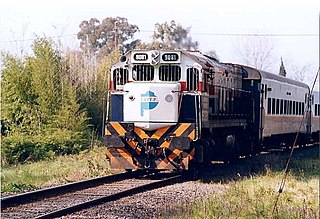
The Unidad Ejecutora del Plan Ferroviario Provincial (UEPFP) (in English: "Executive Unit of the Provincial Railway Plan"), mostly known under its trade name Ferrobaires, was a public railway company which operated extensive long-distance passenger trains throughout the Buenos Aires Province in Argentina. The company was primarily owned and funded by the Buenos Aires provincial government led by Eduardo Duhalde. The name "Ferrobaires" is a combination of the Spanish words for "Rail Buenos Aires."

Retiro is the name of a railway station complex in Buenos Aires, Argentina, that includes three main terminal train stations and two terminal subway stations.

Once railway station is a large railway terminus in central Buenos Aires, Argentina, in the barrio of Balvanera.
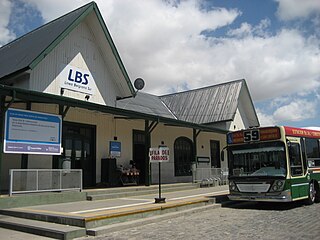
Buenos Aires is a former passenger railway station in the city of Buenos Aires, Argentina. The station was terminus of the Belgrano Sur line that runs trains along Greater Buenos Aires region.

Federico Lacroze railway station is a passenger railway station in Buenos Aires, Argentina. The station is located in the city's outlying barrio (neighbourhood) of Chacarita in a predominantly residential area. It is just a short distance north of the Cementerio de la Chacarita, the city's largest cemetery. The station is named after Federico Lacroze, a prominent 19th century Argentine railway and transport pioneer who obtained the concession for building the Buenos Aires Central Railway in 1884. When the Argentine railway network was nationalised in 1948 the station became the Buenos Aires terminus for the lines that became part of the General Urquiza Railway (FCGU).

The General Bartolomé Mitre Railway (FCGBM), named after the former Argentine president Bartolomé Mitre, is one of the six state-owned Argentine railway lines formed after President Juan Perón's nationalisation of the railway network in 1948 and one of the largest of Argentina. The six divisions, managed by Ferrocarriles Argentinos were later broken up during the process of railway privatisation beginning in 1991 during Carlos Menem's presidency.

The General Manuel Belgrano Railway (FCGMB), named after the Argentine politician and military leader Manuel Belgrano, is a 1,000 mmmetre gauge railway and the longest of the Argentine system. It was one of the six State-owned Argentine railway companies formed after President Juan Perón's nationalisation of the railway network in 1948.
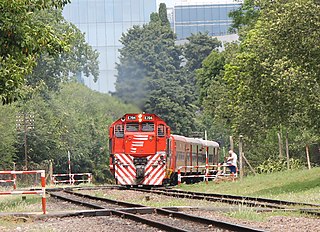
The Belgrano Norte line is a commuter rail service in Buenos Aires, Argentina run by the private company Ferrovías since 1 April 1994. This service had previously been run by the state-owned General Belgrano Railway since nationalisation of the railways in 1948. Ferrovías also formed part of the consortium Unidad de Gestión Operativa Ferroviaria de Emergencia (UGOFE) which operated other commuter rail services in Buenos Aires.
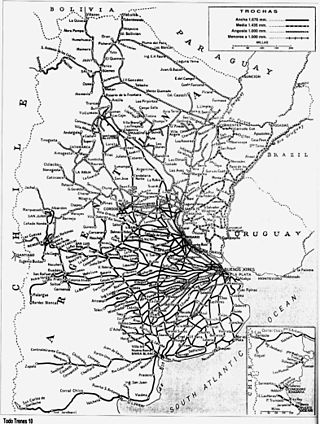
The Argentine railway network consisted of a 47,000 km (29,204 mi) network at the end of the Second World War and was, in its time, one of the most extensive and prosperous in the world. However, with the increase in highway construction, there followed a sharp decline in railway profitability, leading to the break-up in 1993 of Ferrocarriles Argentinos (FA), the state railroad corporation. During the period following privatisation, private and provincial railway companies were created and resurrected some of the major passenger routes that FA once operated.

Retiro bus station is the main bus terminal in Buenos Aires, Argentina. It is situated in the Retiro district, two blocks north of Retiro railway station.
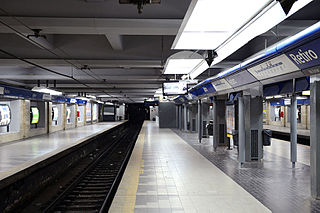
Retiro is a station on Line C of the Buenos Aires Underground and is the current terminus. The station is a part of the larger Retiro railway station which connects to the Mitre, San Martín and Belgrano railways, as well as their corresponding commuter rail lines. The station was opened on 6 February 1936 as part of the extension of the line from Diagonal Norte.

Retiro is the terminus station on Line E of the Buenos Aires Underground. The station is part of the larger Retiro railway station which connects to the Mitre, San Martín and Belgrano railways, as well as their corresponding commuter rail lines. The station was opened on 3 June 2019 as part of the extension of the line from Bolívar.

The Buenos Aires Metrobús is a 50.5 km (31.4 mi) network of dedicated separated lanes and stations for buses that serve the city of Buenos Aires, Argentina. Designed as a Bus Rapid Transit system, it mixes a few bi-articulated buses with conventional buses. The headway is the same as before the implementation of the system, and the buses on the system use the same brand as the main network, that is, maintaining their previous branding as common bus lines with their own numbers. The service operates 24 hours a day and 365 days a year, with 2-4 minute frequencies during the day and 10–15 minutes at night.

Operadora Ferroviaria Sociedad del Estado (SOFSE), trading as Trenes Argentinos Operaciones, is an Argentine state-owned company created in 2008 to operate passenger services in Argentina. It operates as a division of Ferrocarriles Argentinos S.E..

The first trams in Buenos Aires began operating in 1863 in what quickly became a vast network of tramways with the city being known as the "City of Trams" for having the highest tramway-to-population ratio in the world. In the 1920s, Buenos Aires had 875 km (544 mi) of tramways and 99 tram lines using 3000 carriages running throughout the city. By 1963, the vast majority of the network began to be dismantled, though some minor tram services continue in the city today.

The Regional Express Network was a planned commuter network system in Buenos Aires, which consisted in an underground connection among the 3 mainline railway stations of the city: Retiro, Constitucion and Once, in the north, south and west respectively.

Retiro-Mitre, or simply Retiro, is one of the six large mainline railway station termini in Buenos Aires, Argentina. Located in the neighborhood of Retiro, it serves as terminal station for the Mitre Line that runs local trains to the northern suburbs of the Buenos Aires metropolitan area. It also functions as terminal station for the national General Mitre Railway, being one of Argentina's largest railway stations..

Retiro-San Martín, or simply Retiro, is one of the six large mainline railway station termini in Buenos Aires, Argentina. Located in the neighborhood of Retiro, it serves as terminal station for the San Martín Line that runs local trains to the northwestern suburbs of the Buenos Aires metropolitan area. It also functions as terminal station for the national train General San Martín Railway.

























